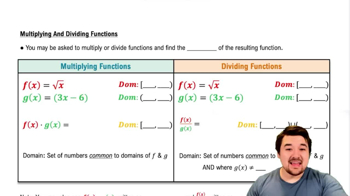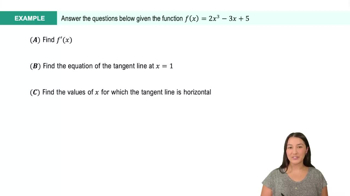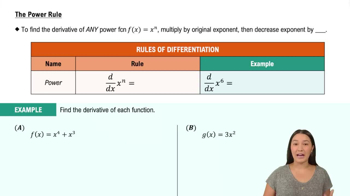Table of contents
- 0. Functions7h 52m
- Introduction to Functions16m
- Piecewise Functions10m
- Properties of Functions9m
- Common Functions1h 8m
- Transformations5m
- Combining Functions27m
- Exponent rules32m
- Exponential Functions28m
- Logarithmic Functions24m
- Properties of Logarithms34m
- Exponential & Logarithmic Equations35m
- Introduction to Trigonometric Functions38m
- Graphs of Trigonometric Functions44m
- Trigonometric Identities47m
- Inverse Trigonometric Functions48m
- 1. Limits and Continuity2h 2m
- 2. Intro to Derivatives1h 33m
- 3. Techniques of Differentiation3h 18m
- 4. Applications of Derivatives2h 38m
- 5. Graphical Applications of Derivatives6h 2m
- 6. Derivatives of Inverse, Exponential, & Logarithmic Functions2h 37m
- 7. Antiderivatives & Indefinite Integrals1h 26m
- 8. Definite Integrals4h 44m
- 9. Graphical Applications of Integrals2h 27m
- 10. Physics Applications of Integrals 2h 22m
3. Techniques of Differentiation
Basic Rules of Differentiation
Problem 3.28
Textbook Question
Derivatives Find the derivative of the following functions. See Example 2 of Section 3.2 for the derivative of √x.
g(t) = 6√t
 Verified step by step guidance
Verified step by step guidance1
Step 1: Recognize that the function g(t) = 6√t can be rewritten using exponent notation as g(t) = 6t^{1/2}.
Step 2: Apply the power rule for differentiation, which states that if f(t) = t^n, then f'(t) = n*t^{n-1}.
Step 3: Differentiate g(t) = 6t^{1/2} using the power rule. The derivative of t^{1/2} is (1/2)t^{-1/2}.
Step 4: Multiply the derivative of t^{1/2} by the constant 6, resulting in g'(t) = 6 * (1/2)t^{-1/2}.
Step 5: Simplify the expression to find the derivative g'(t) = 3t^{-1/2}.
 Verified video answer for a similar problem:
Verified video answer for a similar problem:This video solution was recommended by our tutors as helpful for the problem above
Video duration:
2mPlay a video:
Was this helpful?
Key Concepts
Here are the essential concepts you must grasp in order to answer the question correctly.
Derivatives
A derivative represents the rate of change of a function with respect to its variable. It is a fundamental concept in calculus that provides information about the slope of the tangent line to the curve of the function at any given point. The derivative can be computed using various rules, such as the power rule, product rule, and chain rule.
Recommended video:

Derivatives
Power Rule
The power rule is a basic technique for finding the derivative of functions of the form f(x) = x^n, where n is a real number. According to this rule, the derivative f'(x) is given by n*x^(n-1). This rule simplifies the differentiation process, especially for polynomial functions and can be applied to functions involving roots, such as √t.
Recommended video:
Guided course

Power Rules
Square Root Function
The square root function, denoted as √x, is a specific type of function that returns the non-negative square root of x. In calculus, it is important to understand how to differentiate this function, as it can be expressed in terms of exponents (x^(1/2)). This transformation allows the application of the power rule to find its derivative effectively.
Recommended video:

Multiplying & Dividing Functions

 3:59m
3:59mWatch next
Master Derivatives of Linear Functions with a bite sized video explanation from Callie
Start learningRelated Videos
Related Practice







